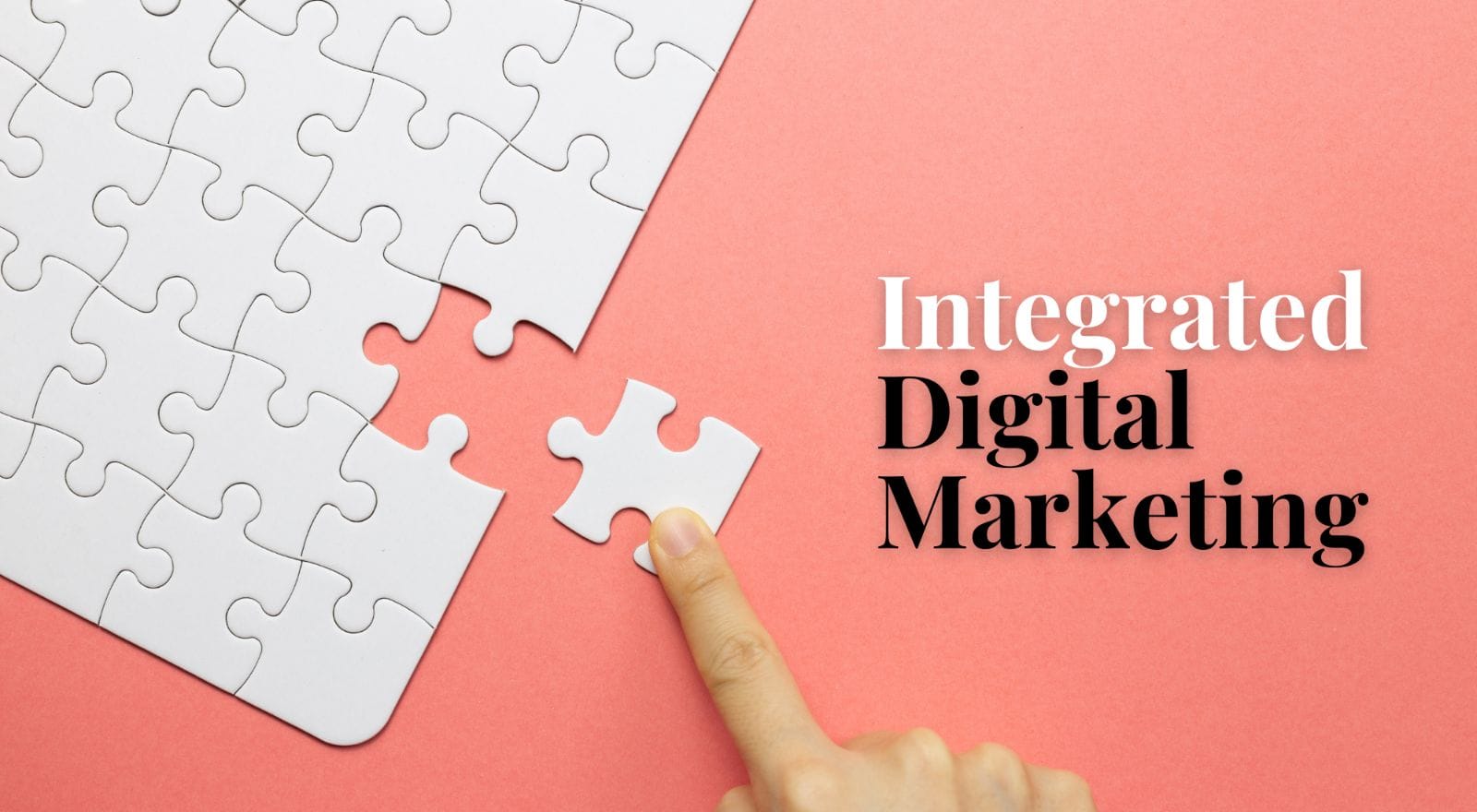The What, Why and How of Integrated Digital Marketing: A Complete Guide

The integrated digital marketing approach helps businesses achieve better results with their marketing efforts and maximise the impact of their marketing budget. In this article, we will explore what integrated digital marketing is, its advantages, and how you can implement an integrated strategy for your digital marketing efforts.
What is Integrated Digital Marketing?
Integrated digital marketing is a strategy that combines different digital channels and techniques in a coordinated way to improve a brand’s online presence and effectiveness.
The core idea of integrated digital marketing is that using individual digital channels—like paid advertising, organic search, and owned media such as social media and email—by themselves may not significantly impact your online presence. However, using them together in a cohesive manner can greatly boost a brand’s online effectiveness.
Therefore the shift towards integrated solutions is becoming increasingly popular among businesses, as it has been recognised that an integrated digital marketing strategy offers enhanced customer experience, improved marketing campaign efficiency and higher returns on investment.
See also 10 Integrated Digital Marketing Case Studies to Inspire You.
Components of an Integrated Digital Marketing Strategy
The main goal of an integrated digital marketing strategy is to ensure that all these different elements of digital marketing work together in harmony. This synergy allows the seamless combination of elements that enhance each other’s effectiveness. Its key components include:
1. Website Design & Development
A website is a business’s “digital headquarters”. The bedrock of successful digital marketing efforts starts with creating a website that prioritises mobile users, offers an intuitive user experience, has a fast loading speed, and is optimised for both user engagement and search engine visibility. See also 10 Brilliant Website Design Examples for Inspiration.
2. Search Engine Optimisation (SEO)
SEO ensures online content is easily discoverable on search engines by enriching the content with relevant keywords, meta tags, and inbound and outbound link building, which can boost visibility and rankings on search engine result pages. See also What is SEO & Why is It Important to Your Business?
3. Content Marketing
Content is at the heart of digital marketing. Relevant, valuable, and engaging content to attract and retain a clearly defined audience. This includes blog posts, articles, eBooks, videos, webinars, infographics etc. See also SEO Content Writing: 10 Tips to Write Content and Win Every Time.
4. Pay Per Click (PPC) Advertising
PPC campaigns can amplify your reach on search engines and social media platforms. Platforms like Google Ads, Facebook Ads, Instagram Ads, LinkedIn Ads, TikTok etc., allow businesses to connect with targeted audiences using bespoke ads. See also How to Use Pay-Per-Click (PPC) Advertising to Drive Sales.
5. Email Marketing
Being one of the most effective ways to maintain a close relationship with an audience, email marketing is an important digital marketing component to help retain existing customers and convert prospects by regularly sending newsletters, promotional messages, and personalised offers.
6. Social Media Marketing
Social media platforms offer a great way to engage with your audience, build relationships, and distribute your content. Each platform (e.g., Facebook, Twitter, Instagram, LinkedIn, TikTok etc.) has their unique user base and style of content, and strategies are tailored accordingly. See also The Ultimate Social Media Guide for Businesses.
7. Online Reputation Management
Online Reputation Management (ORM) is the process of monitoring, influencing, and controlling an individual’s or organisation’s reputation across the internet. It involves tracking what is said about a person or brand online, responding to customer queries and concerns, managing customer reviews, and ensuring accurate information and consistent brand message across all online channels. See also Benefits and 8 Proven Strategies for Online Reputation Management.
8. Marketing Analytics
This component involves tracking, measuring, and analysing the performance of your digital marketing campaigns. Tools like Google Analytics, Adobe Analytics, social media insights, etc., help marketers understand what is working and what isn’t, enabling them to optimise their strategies.
9. Automation and Artificial Intelligence (AI)
Automation tools can streamline digital marketing tasks to enhance efficiency and productivity. AI is increasingly utilised in personalisation, predictive analysis, customer segmentation, and chatbot services. See also 5 Game-Changing Impacts of AI & Machine Learning on Digital Marketing.
10. Personalisation and Customer Experience
Personalisation involves crafting customised experiences to meet the unique needs of customers based on their preferences, behaviour, and purchase history. An excellent customer experience at all touchpoints is crucial to customer satisfaction and loyalty. See also Personalisation: How to Win With Tailored Customer Experiences.
When each element of the digital marketing mix is aligned and working towards the same objectives, the overall marketing efforts of a business can be amplified, leading to increased visibility, engagement, and return on investment. For example, an e-commerce business that is putting out a new product might use more than one digital marketing strategy to get the word out. This may include:
- Search Engine Optimisation (SEO): To optimise its website design and product pages to make it easier for potential customers and search engines to find information about the new product.
- Social Media Marketing: To promote the product, create posts and ads highlighting its key features and benefits across multiple social media platforms.
- Content Marketing: To create blog posts, videos, and other types of content that educate potential customers about the new product and why they should care.
- Email Marketing: To send out a series of email campaigns to its subscribers, promoting the new product and links to the blog content with additional information about its features and benefits.
- Influencer Marketing: To partner with influencers in its target market and promote the product, leveraging the influencer’s audience to reach new potential customers.
By combining different strategies and channels, brands can make a marketing plan that is more holistic and effective. This allows them to communicate with customers in a variety of different ways. However, it goes beyond the use of multiple strategies and channels. It also focuses on ensuring the brand experience is the same and consistent across all digital touchpoints.
For all these activities, they would ideally use similar imagery, messaging, and other campaign elements to drive a cohesive, consistent message in an engaging and relevant way.

Why: The Importance Of Integrated Digital Marketing Strategy
When your marketing efforts are fragmented and isolated, it’s easy to squander valuable resources like time and money on strategies that don’t contribute to your overall marketing goals. For instance, you could be pouring money into a social media campaign that fails to connect with your target audience or investing in content production that doesn’t reflect your brand’s message.
These non-cohesive efforts often result in a disappointing return on investment (ROI). Worse still, your potential customers could be left confused due to inconsistent messaging while failing to meet your current customers’ expectations due to a lack of a comprehensive understanding of the customer journey.
Compounding this issue, the slow death of third-party cookies is progressively reducing ad effectiveness and increasing the cost of customer acquisition across digital platforms. All in the middle of global economic uncertainty and companies cutting down on their advertising dollars, you need to get the biggest bang for your buck more than ever.
This is why the integrated digital marketing approach is highly recommended and becoming increasingly appealing to savvy businesses than ever.
Advantages of Integrated Digital Marketing Strategy
Integrated digital marketing offers a number of significant advantages for businesses, including the following:
1. Reach Your Target Audience Where They Are
Customers today engage with companies through many digital channels, such as websites, social media, mobile devices, and many more. With an integrated strategy for digital marketing, businesses can communicate with the members of their target audience through the mediums of their choice. This ensures that their message is sent in the setting where the consumer is most likely to see it.
2. Deliver a Message That is Consistent and Effective
Businesses may develop a consistent, effective message that connects with their target audience by combining diverse marketing strategies and platforms. Because of this, customers are exposed to a unified and coherent message throughout all of the brand’s touchpoints, which helps to develop trust and credibility with the target audience.
3. Track and Measure Results
Integrated digital marketing campaigns can help businesses track and measure the results of their marketing activities holistically. This enables them to better understand what marketing techniques are successful and tailor their plans to fit those successes. Therefore, businesses can make decisions based on data and increase their return on investment.
4. Reach a Wider Audience
Combining types of digital marketing strategies and channels can help businesses reach a wider audience effectively. This is of utmost significance for businesses that focus on acquiring particular types of customers. Brands can communicate with their target audience in a manner that is pertinent to their needs and personalised.
5. Build Stronger Relationships With Customers
Integrated digital marketing enables businesses to develop greater relationships with their consumers by offering consistent and engaging experiences across various touchpoints. This helps businesses build stronger ties with their customers, which in turn helps them grow. This results in improved client loyalty and repeat business, all essential to achieving long-term success in today’s highly competitive digital world.
6. Higher Return on Investment
Traditional marketing often involves fragmented and disconnected efforts that can significantly drain your budget. However, an integrated digital marketing strategy aligns all aspects of your digital marketing to work together towards a cohesive narrative. This is especially crucial in today’s market, where the cost of acquiring new customers is rising due to the declining use of third-party cookies.
7. Improve the Customer Journey
Implementing an integrated digital marketing strategy can make it easier for consumers to interact with a brand by providing a more tailored experience for customers and optimising their journey. Customers can subsequently find it easier to interact with the brand and enjoy a more pleasant experience—a perfect recipe for increased loyalty and repeat business.
8. Stay Ahead of the Competition
Businesses can stay ahead of the competition by adopting an integrated digital marketing approach. They can leverage the most recent technologies and strategies to reach their target audience in a more effective and efficient manner, allowing them to stay ahead of the competition.
How to Implement an Integrated Digital Marketing Strategy
Implementing an integrated digital marketing strategy requires a comprehensive and systematic approach. Here are the steps to take to implement a successful integrated digital marketing strategy:
1. Define and Understand Your Target Audience
The first step in developing a successful integrated digital marketing plan is understanding your intended audience’s demographics. This involves having an awareness of your consumers’ demographics, as well as their requirements, interests, and the factors that drive them to interact with your business. Social listening is a fantastic way to understand your target market. See also What is Social Listening? Expert Guide with Examples, Benefits & Tools.
2. Audit Your Marketing Activities
Conduct a marketing analysis to evaluate the marketing activities you are currently engaged in and locate any weaknesses or opportunities for improvement. This will assist you in understanding the areas in which your present efforts are succeeding and the areas in which they are failing, allowing you to make necessary modifications in accordance with the findings.
3. Set Clear Goals and Objectives
Define the goals and objectives that you want to achieve with your integrated digital marketing strategy to help you create a plan to attain those goals and objectives. This may involve increasing consumers’ awareness of your brand, attracting more visitors to your website, generating more leads, or increasing sales.
4. Create a Content Plan
Create a content strategy that will assist you in reaching out to and engaging with the audience you are trying to reach. This should contain a plan for developing and delivering high-quality content that connects with your target audience and supports your marketing goals. This plan should also include repurposing content and optimising them for different channels for best results.
5. Choose the Right Strategies and Channels
When it comes to marketing, it’s important to pick strategies and channels that will be the most successful in terms of reaching your target audience and accomplishing your marketing objectives. This may involve online advertising like Google Ads PPC, search engine optimisation (SEO), social media marketing, email marketing, and other online marketing strategies.
6. Measure and Track Results
Implement tools and procedures to track, evaluate and monitor the results of your integrated digital marketing initiatives. Because of this, you will better understand what is working and what is not, allowing you to make decisions based on facts and adjust your plan accordingly.
7. Keep Optimising
You must continuously optimise your integrated digital marketing strategy based on the performance to maximise your results. This might require you to make changes to your content strategy, get more specific with your targeting, or investigate new channels and strategies.
In the end, an integrated digital marketing strategy aims to create an elevated customer experience while maximising return on investment at the same time. This is especially powerful because customers expect personalised, useful, and enjoyable experiences from the brands they engage with. According to a Salesforce report, 9 out of 10 respondents will likely enjoy receiving personalised offers based on their interests and browsing or purchase history.
Customer experience is the new marketing battlefront.
Chris Pemberton
An integrated digital marketing approach allows businesses to gather and utilise data from multiple channels to glean a comprehensive and nuanced understanding of their customers across different channels and provide a tailored marketing experience. This can result in increased engagement and loyalty as customers will likely continue using a brand that feels specifically designed for them. As a result, businesses can maximise their marketing efforts and brand awareness to achieve a higher return on investment.
FAQs
Never Miss a Thing!
Subscribe to our blog for the latest expert tips and digital marketing resources.






Great information. I love how you really broke it down into what, why and how. super easy to digest and helpful. Thanks for sharing
It’s great to hear that you found it helpful, Sandra! Don’t hesitate to subscribe to our newsletter to receive more useful content directly in your inbox.